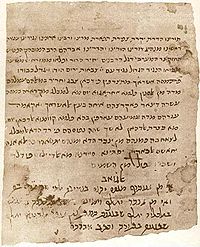You can help expand this article with text translated from the corresponding article in French. (January 2024) Click [show] for important translation instructions.
|
| Judeo-Arabic | |
|---|---|
| ערבית יהודית | |
 A page from the Cairo Geniza, part of which is written in the Judeo-Arabic language | |
| Ethnicity | Jews from North Africa and the Fertile Crescent |
Native speakers | 240,000 (2022)[1] |
Afro-Asiatic
| |
Early forms | |
| Hebrew alphabet | |
| Language codes | |
| ISO 639-2 | jrb |
| ISO 639-3 | jrb – inclusive codeIndividual codes: yhd – Judeo-Egyptian Arabicaju – Judeo-Moroccan Arabicyud – Judeo-Tripolitanian Arabicjye – Judeo-Yemeni Arabic |
| Glottolog | None |
Judeo-Arabic ([ערביה יהודיה] Error: {{Lang-xx}}: invalid parameter: |fn= (help), romanized: ‘Arabiya Yahūdiya; Arabic: عربية يهودية, romanized: ʿArabiya Yahūdiya ; Hebrew: ערבית יהודית, romanized: ‘Aravít Yehudít ) is Arabic, in its formal and vernacular varieties, as it has been used by Jews, and refers to both written forms and spoken dialects.[2][3][4] Although Jewish use of Arabic, which predates Islam, has been in some ways distinct from its use by other religious communities, it is not a uniform linguistic entity.[2]
Varieties of Arabic formerly spoken by Jews throughout the Arab world have been, in modern times, classified as distinct ethnolects.[4] Under the ISO 639 international standard for language codes, Judeo-Arabic is classified as a macrolanguage under the code jrb, encompassing four languages: Judeo-Moroccan Arabic (aju), Judeo-Yemeni Arabic (jye), Judeo-Egyptian Arabic (yhd), and Judeo-Tripolitanian Arabic (yud).[5][4]
Judeo-Arabic, particularly in its later forms, contains distinctive features and elements of Hebrew and Aramaic.[6]: 125 [7]: 35
Many significant Jewish works, including a number of religious writings by Saadia Gaon, Maimonides and Judah Halevi, were originally written in Judeo-Arabic, as this was the primary vernacular language of their authors.
- ^ Judeo-Arabic at Ethnologue (25th ed., 2022)

- ^ a b Khan, Geoffrey (2017-09-01). "Judeo-Arabic". In Kahn; Rubin, Aaron (eds.). Handbook of Jewish Languages (Lily ed.). BRILL. doi:10.1163/9789004359543. ISBN 978-90-04-35954-3.
- ^ Stillman, Norman A. "Judeo-Arabic - History and Linguistic Description". Encyclopedia of Jews in the Islamic World Online. doi:10.1163/1878-9781_ejiw_com_0012320. Retrieved 2024-10-23.
- ^ a b c Cite error: The named reference
Shohat-2017was invoked but never defined (see the help page). - ^ "jrb | ISO 639-3". iso639-3.sil.org. Retrieved 2022-11-13.
- ^ Hary, Benjamin (2012-01-01), "Judeo-Arabic as a Mixed Language", Middle Arabic and Mixed Arabic, Brill, pp. 125–143, doi:10.1163/9789004228047_008, ISBN 978-90-04-22804-7, retrieved 2024-11-02
- ^ Hary, Benjamin; Benor, Sarah Bunin, eds. (2018-11-05), Languages in Jewish Communities, Past and Present, De Gruyter Mouton, doi:10.1515/9781501504631, ISBN 978-1-5015-0463-1, retrieved 2024-11-02